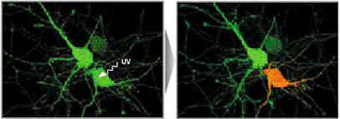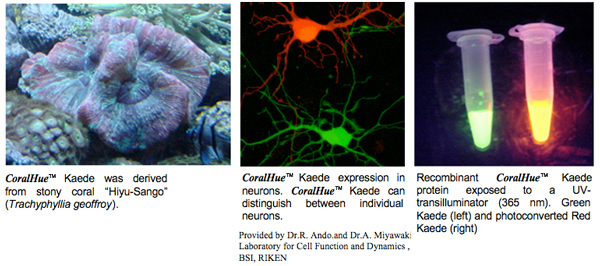Kaede
Suitable for observation of individual cell movements.
- Photoconvertible fluorescent protein
- Optical marking
The fluorescent protein Kaede gene was isolated from the stony coral Trachyphylia geoffroyi (Hiyu-sango in Japanese).
Kaede means maple leaf in Japanese. CoralHue™ Kaede protein emits bright green fluorescence that can irreversibly convert to red. The red fluorescence is comparable in intensity to the green and is stable under usual aerobic conditions. The green-to-red conversion is highly sensitive to irradiation with UV or violet light (350-410 nm). Maximal illumination results in a 2,000-fold increase in the ratio of red-to-green signaling. The excitation lights used to elicit red or green fluorescence do not induce the photoconversion.
This property provides a simple and powerful technique for regional optical marking.
Cell (Ref.2,3), organelle (Ref.4) or protein dynamics (Ref.5,6) have been reported.
Irradiation with UV to Kaede expressing cells converts the green fluorescence to red, which leads to the diffusion of red colored Kaede throughout the Kaede expressing cell. The photoconversion can be induced gradually by intermittent irradiation.

Expression of CoralHue™ Kaede in neurons.
Without irradation with UV, Kaede protein emits green fluorescence which visualize the morphology of neurons (Left). Irradation with UV to the cell body of one neuron elicits the green-to-red fluorescence conversion specifically in the irradiated cell, by which neighboring neurons can be distingueshed by color (Right).
(Images are provided by Dr. Miyawaki
Atsushi, Laboratory for Cell Function and Dynamics,
BSI, RIKEN)


| Kaede spectrum data files (text files) | |
|---|---|
| Kaede-green excitation ( |
Kaede-green emission ( |
| Kaede-red excitation ( |
Kaede-red emission ( |
Note: The file is in a tab-delimited text format. It contains values of the wavelength (0.5nm spacing) and brightness (fluorescence intensity peak value normalized to 1). Use a spreadsheet program to create a spectrum that will help you in choosing the appropriate excitation filter, dichroic mirror and fluorescence filter.
Filter set for Kaede
Filter set for Kaede is available from Opto Science, Inc.
| Set No. | Filter set for Kaede recommended by OMEGA OPTICAL | Components | Part # | Filer models |
|---|---|---|---|---|
| XF153 |
Green to Red Conversion |
Exciter - Red Exciter - Green Dichroic Emitter - Red Emitter - Green Conversion Exciter - UV R to G Conversion Dichroic - UV R to G |
XF1072 XF1021 XF2038 XF3017 XF3089 XF1401 XF2001 |
475AF20 550DF30 430DRLP 530DF30 575ALP 380DF30 400DCLP |
※For further information, please see Opto Science, Inc. webpage
| CHARACTERISTIC | CoralHue™ Kaede | CoralHue™ Kaede (photoconverted) |
|---|---|---|
| Oligomerization | Tetramer | Tetramer |
| Number of amino acid | 225 | 225 |
| Excit./Emiss. maxima (nm) | 508 / 518 | 572 / 580 |
| Molar extinction coefficient (M-1cm-1) | 98,800 (508 nm) | 60,400 (572 nm) |
| Fluorescence quantum yield | 0.88 | 0.33 |
| Brightness*1 | 86.9 | 19.9 |
| pH sensitivity | pKa=5.6 | pKa=5.6 |
| Cytotoxicity*2 | No | No |
*1Brightness: Molar Extinction Coefficient ×Fluorescence Quantum Yield / 1000
*2Toxicity when expressed in HeLa cells
Kaede transgenic mouse
The Kaede transgenic mouse was developed by Dr. Miwa (Ref.2). Kaede is a photoconvertible fluorescence protein that changes from green to red upon exposure to violet light. The photoconversion of intracellular Kaede has no effect on cellular function. Thus, Cell dynamics can be monitored with the photoconverted Kaede protein.
Provided by Dr.Y. Miwa
Department of Molecular Pharmacology, Graduate School of Comprehensive Human Sciences, University of Tsukuba

Visualization of cell movements and the tracing of neuronal shapes using Kaede transgenic zebrafish (Ref.3)
Recommended antibodies
CoralHue™ Kaede can be recognized using antibodies as shown below.
WB: Western blotting, IP: Immunoprecipitation
References
- Ando R, Hama H, Yamamoto-Hino M, Mizuno H, Miyawaki A. An optical marker based on the UV-induced green-to-red photoconversion of a fluorescent protein. Proc Natl Acad Sci U S A. (2002) 99(20):12651-6. PMID: 12271129
- Tomura M, Yoshida N, Tanaka J, Karasawa S, Miwa Y, Miyawaki A, Kanagawa O. Monitoring cellular movement in vivo with photoconvertible fluorescence protein "Kaede" transgenic mice. Proc Natl Acad Sci U S A. (2008) 105(31):10871-6. PMID: 18663225
- Hatta K, Tsujii H, Omura T. Cell tracking using a photoconvertible fluorescent protein. Nat Protoc. (2006) 1(2):960-7. PMID: 17406330
- Watanabe W, Shimada T, Matsunaga S, Kurihara D, Fukui K, Shin-Ichi Arimura S, Tsutsumi N, Isobe K, Itoh K. Single-organelle tracking by two-photon conversion. Opt Express. (2007) 15(5):2490-8. PMID: 19532486
- Schmidt A, Wiesner B, Weisshart K, Schulz K, Furkert J, Lamprecht B, Rosenthal W, Schulein R. Use of Kaede fusions to visualize recycling of G protein-coupled receptors. Traffic. (2009) 10(1):2-15. PMID: 18939954
- Leung KM, Holt CE. Live visualization of protein synthesis in axonal growth cones by microinjection of photoconvertible Kaede into Xenopus embryos. Nat Protoc. (2008) 3(8):1318-27. PMID: 18714300
※CoralHue™ fluorescent proteins were co-developed with the Laboratory for Cell Function and Dynamics, the Advanced Technology Development Center, the Brain Science Institute, RIKEN. MBL possesses the license and deals in the products.
Please send us a completed and signed License Acknowledgement.
Please note that the product will be shipped after we receive a
completed and signed License Acknowledgement (PDF file on the right).
Prior to shipping, our staff may contact you to verify the intended use
of the product. Please also note that a separate agreement or a contract
may be required depending on the intended use.
The product you have ordered is sold for research purpose only. It is
not intended for industrial or clinical use, and shall not be used for
any purposes other than research. You are also asked not to hand over or
resell the product to a third party.
If you belong to a profit organization or a business corporation, or
wish to use the product for profit or commercial purposes, please
contact us.

- Fluorescent protein
- Basic fluorescent proteins
- Midoriishi-Cyan [Outline] [Product list]
- Umikinoko-Green [Outline] [Product list]
- Azami-Green [Outline] [Product list]
- Kusabira-Orange [Outline] [Product list]
- dKeima570 [Outline] [Product list]
- Keima-Red [Outline] [Detection of mitophagy with Keima-Red] [Product list]
- Photoconvertible fluorescent proteins
- Dronpa-Green [Outline] [Product list]
- Kaede [Outline] [Product list]
- Kikume Green-Red [Outline] [Product list]
- Organelle targeting vectors [Product list]
- Advanced fluorescent indicators
- Image based Protein-Protein interaction analysis "Fluoppi" [Outline] [Fluoppi Red] [Product list]
- Cell cycle indicator "Fucci" [Outline] [Product list]
- Protein-Protein Interaction Detection System "CoralHue™ Fluo-chase Kit" [Outline] [Product list]
- Anti-CoralHue™ fluorescent protein antibodies
- Anti-CoralHue™ fluorescent protein antibodies [Outline] [Product list]
- Resources
- CoralHue™ vectors full DNA sequence
- Spectrum



